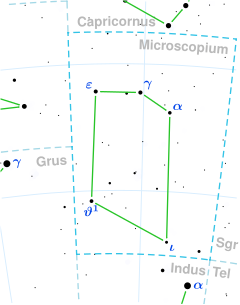| Observation data Epoch J2000 Equinox J2000 | |
|---|---|
| Constellation | Microscopium [1] |
| Right ascension | 21h 12m 13.71281s [2] |
| Declination | −40° 16′ 09.7010″ [2] |
| Apparent magnitude (V) | 5.83 [3] (5.83 - 5.86) [4] |
| Characteristics | |
| Evolutionary stage | main sequence [2] |
| Spectral type | F5 V [5] [6] |
| B−V color index | +0.45 [3] |
| Variable type | suspected [4] |
| Astrometry | |
| Radial velocity (Rv) | 4.5±0.9 [7] km/s |
| Proper motion (μ) | RA: +58.359 mas/yr [2] Dec.: −218.773 mas/yr [2] |
| Parallax (π) | 31.4586±0.0401 mas [2] |
| Distance | 103.7 ± 0.1 ly (31.79 ± 0.04 pc) |
| Absolute magnitude (MV) | +3.33 [1] |
| Details | |
| Mass | 1.28 [8] M☉ |
| Radius | 1.47+0.07 −0.04 [9] R☉ |
| Luminosity | 3.79±0.01 [2] L☉ |
| Surface gravity (log g) | 4.21±0.01 [10] cgs |
| Temperature | 6,637±80 [11] K |
| Metallicity [Fe/H] | +0.06±0.01 [12] dex |
| Rotational velocity (v sin i) | 25.1±2.5 [13] km/s |
| Age | 916 [8] Myr |
| Other designations | |
| 55 G. Microscopii [14] , NSV 25506, CD−40°14216, CPD−40°9488, GC 29614, GJ 9726, HD 201647, HIP 104680, HR 8100, SAO 230575, LTT 8410, TIC 159670453 [15] | |
| Database references | |
| SIMBAD | data |
HD 201647 (HR 8100; Gliese 9726; LTT 8410) is a solitary star [16] located in the southern constellation of Microscopium. It is faintly visible to the naked eye as a yellowish-white-hued star with an apparent magnitude of 5.83. [3] The object is located relatively close at a distance of light-years based on Gaia DR3 parallax measurements, but it is receding with a heliocentric radial velocity of 4.5 km/s . [7] At its current distance, HD 201647's brightness is diminished by 0.11 magnitudes due to interstellar extinction [17] and it has an absolute magnitude of +3.33. [1] It has a relatively high proper motion across the celestial sphere, moving at a rate of 226.331 mas/yr. [18]
HD 201647 has a stellar classification of F5 V, [6] [5] indicating that it is an ordinary F-type main-sequence star that is generating energy via hydrogen fusion at its core. It has 1.28 times the mass of the Sun [8] and 1.47 times the radius of the Sun. [9] It radiates 3.79 times the luminosity of the Sun [2] from its photosphere at an effective temperature of 6,637 K . [11] HD 201647 is slightly metal enriched with an iron abundance of [Fe/H] = +0.06 or 115% of the Sun's. [12] It is estimated to be 916 million years old [8] and it spins modestly with a projected rotational velocity of 25.1 km/s . [13]
In the discovery paper for Lacaille 8760, HD 201647 was reported to be a variable star that varied between 5.83 and 5.86 in the visual passband. [4] As of 2004 however, it has not been confirmed to be variable. [19]
